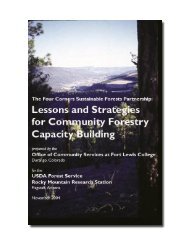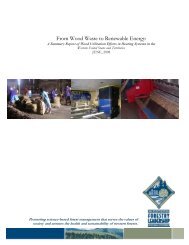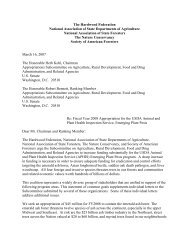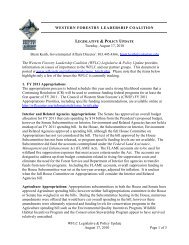Emission Controls for Small Wood-Fired Boilers - Western Forestry ...
Emission Controls for Small Wood-Fired Boilers - Western Forestry ...
Emission Controls for Small Wood-Fired Boilers - Western Forestry ...
Create successful ePaper yourself
Turn your PDF publications into a flip-book with our unique Google optimized e-Paper software.
4.10 Annual Tune Up<br />
Annual tune ups are typically per<strong>for</strong>med on wood boilers. The annual tune up includes a comprehensive<br />
inspection of the combustor, boiler and pollution control system components.<br />
Adjustments/improvements to system components are per<strong>for</strong>med as needed. Combustion efficiency is<br />
typically measured when the annual tune up is per<strong>for</strong>med.<br />
5.0 ADD‐ON POLLUTION CONTROLS<br />
Add‐on pollution controls are emission control devices which remove pollutants from the exhaust gas<br />
stream somewhere between the boiler combustion chamber and the exhaust stack. They are installed<br />
when the combustion equipment cannot reduce emissions to a desired level. In the absence of a fixed<br />
BACT requirement, 1 emission controls are determined on a case by case basis and are a function of the<br />
following: level of uncontrolled emissions, applicable state/federal emission limits, existing ambient<br />
pollutant concentrations (background concentrations), stack height and stack proximity of stack to<br />
sensitive populations. Potential add‐on controls reviewed <strong>for</strong> this study include cyclones, multicyclones,<br />
high efficiency multicyclones (HEMCs), core separators, electrostatic precipitators (ESPs) and baghouses<br />
(fabric filters). The Core Separator was determined in the 2001 emission control report by Resource<br />
Systems Group as the Best Available Control Technology (BACT) <strong>for</strong> small wood‐fired boilers burning a<br />
wood chip type fuel and capable of limiting PM10 emissions to 0.1 lb/MMBtu. 2 The Core Separator will<br />
be discussed in further detail later in this section. Again, the conclusions of this report were accepted by a<br />
consortium of New England states, they did not translate into a <strong>for</strong>mal BACT determination at the federal<br />
level.<br />
This section will focus on add‐on controls <strong>for</strong> reducing filterable particulate matter because <strong>for</strong> the boiler<br />
size range considered in this study, combustion controls are used to limit emissions of other pollutants<br />
such as condensable particulate matter, nitrogen oxides (NOx), carbon monoxide (CO), volatile organic<br />
compounds (VOCs) and most hazardous air pollutants (HAPs or “air toxics”). Add‐on controls are not<br />
discussed <strong>for</strong> sulfur dioxide (SO 2 ) given the low sulfur content of biomass. Combustion controls <strong>for</strong><br />
pollutants other than particulate matter are summarized later in this report.<br />
5.1 Mechanical Collectors<br />
Mechanical collectors use centrifugal <strong>for</strong>ces to separate particulate matter from an exhaust gas stream.<br />
Mechanical collectors include single cyclones, multicyclones, high efficiency multicyclones (HEMCs) and<br />
core separators. They are often used as exhaust gas pre‐cleaners <strong>for</strong> other control devices, such as<br />
baghouses or ESPs.<br />
The exhaust gas flow rate is directly proportional to the operating load of the boiler. Pressure drop, an<br />
indicator of centrifugal separation <strong>for</strong>ce which removes particles from exhaust, is directly proportional to<br />
the exhaust gas flow rate. There<strong>for</strong>e, mechanical collectors work best when operating at their respective<br />
design (maximum) pressure drop.<br />
1<br />
Massachusetts currently requires all wood boilers meeting the state permit applicability threshold meet a PM10 emission limit of 0.10<br />
lb/MMBtu.<br />
2<br />
An Evaluation of Air Pollution Control Technologies <strong>for</strong> <strong>Small</strong> <strong>Wood</strong>‐<strong>Fired</strong> <strong>Boilers</strong>.” Prepared <strong>for</strong> Vermont Department of Public Service;<br />
Vermont Department of Environmental Conservation, Air pollution Control Division; New Hampshire Governor’s Office of Energy<br />
Resources and Community Services; and the Massachusetts Division of Energy Resources. Resource Systems Group, Inc., White River<br />
Junction, VT. Revised, September 2001.<br />
Resource Systems Group, Inc.<br />
<strong>Emission</strong> Control Technologies <strong>for</strong> <strong>Small</strong> <strong>Wood</strong>‐<strong>Fired</strong> <strong>Boilers</strong><br />
6 May 2010 Page 16










